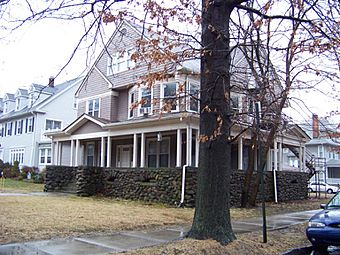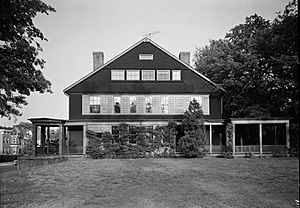Whitney Avenue Historic District facts for kids
Quick facts for kids |
|
|
Whitney Avenue Historic District
|
|
 |
|
| Location | Roughly bounded by Burns St., Livingston St., Cold Spring St., Orange St., Bradley St., and Whitney Ave., New Haven, Connecticut |
|---|---|
| Area | 203 acres (82 ha) |
| NRHP reference No. | 88003209 |
| Added to NRHP | February 2, 1989 |
The Whitney Avenue Historic District is a special area in the East Rock neighborhood of New Haven, Connecticut. It's called a historic district because it has many old and important buildings. This district covers about 203 acres, which is like 150 football fields!
When it was added to the National Register of Historic Places in 1989, it had 1,084 buildings that helped make it historic. These are called "contributing buildings."
The district is next to Edgerton Park and East Rock Park on its north side. It also touches the Prospect Hill Historic District to the west. The Orange Street Historic District is to the east. Parts of Yale University are also nearby to the southwest and south.
The district gets its name from Whitney Avenue, which is the main street running through it. Along Whitney Avenue, you'll see many large, fancy houses and mansions. The smaller streets in the district usually have smaller, cozy homes.
Why is this District Special?
The Whitney Avenue Historic District is important because it shows how New Haven grew in the late 1800s and early 1900s. It was a popular place for middle and upper-class families to live, like a fancy suburb. The area has kept its original look and feel very well.
The houses here show off many different building styles from the past. You can see great examples of Queen Anne, Shingle, Colonial Revival, and Tudor Revival styles. These buildings help tell the story of architecture in the area.
In 1989, there were 749 main buildings in the district. Most of these were houses, but there were also schools, small shops, and even a fire station. Including smaller buildings like garages, there were 1,113 buildings in total. Most of them were considered "contributing" to the historic feel. Even though some old garages have been taken down, the district still looks much like it did many years ago.
Homes in the District

You'll find the biggest and grandest houses mainly along Whitney Avenue and Livingston Street.
Some cool examples of the Queen Anne style include the William Allen House at 357 Whitney Avenue. It's one of many beautiful Queen Anne homes on that street.
For Shingle style houses, check out:
- The house at 519 Whitney Avenue, which is on the corner of Canner Street.
- The Charles Atwater House at 321 Whitney Avenue. This house was designed by famous architects Babb, Cook and Willard.
- The Abner Hendee House at 703 Whitney Avenue.
If you like Colonial Revival style, look for:
- The C. Maeller House at 591 Whitney Avenue.
- The Coyle House, which is also nearby.
- The house at 369 Whitney Avenue.
- The Dr. Henry Hessler House, built in 1930, at 370 Livingston Street.
- The Ray Reigeluth House at 340 Livingston Street, built in 1928–29. This house is a copy of another famous house in Litchfield, Connecticut!
- The Louis Ullman House, built in 1916, at 294 Livingston Street.
There are also some amazing Tudor Revival houses, like the Dr. Edwin Butler House at 640 Whitney Avenue, built in 1913.
You can even find other unique styles, like the Colin Ingersoll House at 475 Whitney Avenue. It's a fantastic Chateauesque style building, designed by architect Joseph Northrup.
Mixed in with the houses are apartment buildings, especially along Whitney Avenue. Many of these are shaped like a "U." An example is Brighton Court at 663-667 Whitney Avenue, built around 1915 in the Spanish Colonial Revival style.
Important Public Buildings
Many of the large mansions along Whitney Avenue are now used for public purposes. When the district was first listed as historic, it had ten churches. Four of these churches were considered "contributing properties" because they added to the district's historic value. There are also several schools and a fire station.
Here are some of the important public buildings built for their current uses:
| Building | Date | Address | Style |
|---|---|---|---|
| Troop A Armory | 1906 | 869 Orange Street | Late Gothic Revival style |
| Epworth Methodist Episcopal Church | 1892 | 655 Orange Street | Romanesque style |
| First Baptist Church | 1902 | 205 Edwards Street | Late Gothic Revival style |
| St. Joseph's Catholic Church | 1904 | 129 Edwards Street | Colonial Revival style |
| Swedish Emanuel Congregational Church (Now called "Evangelical Covenant Church") |
1925 | 590 Orange Street | Colonial Revival style |
| St. John's Episcopal Church | 1895 | 400 Humphrey Street | Gothic style |
| St. Thomas's Episcopal Church | 1931 | 830 Whitney Avenue | |
| First Unitarian/Universalist Society | c. 1910 | 608 Whitney Avenue | |
| Worthington Hooker School | 1900 | 180 Canner Street | Beaux Arts style |
| Whitney Station, of the New Haven Fire Department | - | 348 Whitney Avenue | International style |
Shops and Businesses
The district also includes some small shops and businesses. Many of these are at street corners or along Orange Avenue. Sometimes, old houses have been changed to include storefronts. These businesses help serve the people living in the district.
One interesting building is the Hall-Benedict Drug Company Building on Orange Street. It's so special that it's listed on the National Register of Historic Places all by itself!
Another important building is the Masonic Temple at 285 Whitney Avenue. It's a three-story brick building built in 1926 in the Classical Revival style.
What Makes it All Come Together?
The Whitney Avenue Historic District is known for its many beautiful and important houses. The wide, tree-lined streets provide a perfect setting for these homes. Most of the buildings have kept their original materials and designs. All these things together create a strong feeling of history and beauty. This makes the area a truly special place to visit and learn about.
Where is it Located?
The historic district is mostly in the East Rock neighborhood of New Haven, Connecticut. However, it also stretches into the Prospect Hill neighborhood. For example, the houses on the west side of Whitney Avenue are officially part of the Prospect Hill area.




